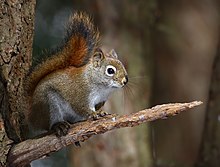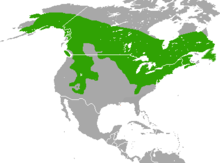
Back سنجاب أحمر أمريكي Arabic سنجاب احمر امريكى ARZ Werpol (Tamiasciurus hudsonicus) AVK Американска червена катерица Bulgarian Gwiñver rous Norzhamerika Breton Esquirol vermell americà Catalan Tamiasciurus hudsonicus CEB Čikarí červený Czech Gemeines Rothörnchen German Tamiasciurus hudsonicus Spanish
| American red squirrel | |
|---|---|

| |
| At Cap Tourmente National Wildlife Area, Quebec | |
| Scientific classification | |
| Domain: | Eukaryota |
| Kingdom: | Animalia |
| Phylum: | Chordata |
| Class: | Mammalia |
| Order: | Rodentia |
| Family: | Sciuridae |
| Genus: | Tamiasciurus |
| Species: | T. hudsonicus
|
| Binomial name | |
| Tamiasciurus hudsonicus (Erxleben, 1777)
| |
| Subspecies[3] | |
| |

| |
| Distribution (including T. fremonti) | |
The American red squirrel (Tamiasciurus hudsonicus) is one of three species of tree squirrels currently classified in the genus Tamiasciurus, known as the pine squirrels (the others are the Douglas squirrel, T. douglasii, and the southwestern red squirrel, T. fremonti). The American red squirrel is variously known as the pine squirrel or piney squirrel, North American red squirrel, chickaree, boomer, or simply red squirrel. The squirrel is a small, 200–250 g (7.1–8.8 oz), diurnal mammal that defends a year-round exclusive territory. It feeds primarily on the seeds of conifer cones, and is widely distributed across much of the United States and Canada wherever conifers are common, except in the southwestern United States, where it is replaced by the formerly conspecific southwestern red squirrel, and along the Pacific coast of the United States, where its cousin the Douglas squirrel is found instead.
The squirrel has been expanding its range into hardwood forests.[4]
- ^ Cassola, F. (2017) [errata version of 2016 assessment]. "Tamiasciurus hudsonicus". IUCN Red List of Threatened Species. 2016: e.T42587A115192299. doi:10.2305/IUCN.UK.2016-3.RLTS.T42587A22250817.en. Retrieved 19 February 2022.
- ^ "Tamiasciurus hudsonicus". NatureServe Explorer. Retrieved 17 April 2024.
- ^ Thorington, R.W. Jr.; Hoffmann, R.S. (2005). "Family Sciuridae". In Wilson, D.E.; Reeder, D.M (eds.). Mammal Species of the World: a taxonomic and geographic reference (3rd ed.). The Johns Hopkins University Press. pp. 754–818. ISBN 978-0-8018-8221-0. OCLC 26158608.
- ^ Goheen, Jacob R.; Swihart, Robert K.; Robins, James H. (2003). "The anatomy of a range expansion: Changes in cranial morphology and rates of energy extraction for North American red squirrels from different latitudes". Oikos. 102 (1): 33–44. Bibcode:2003Oikos.102...33G. doi:10.1034/j.1600-0706.2003.12407.x.

